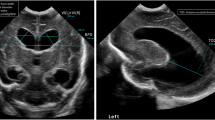Abstract
The CT/MRI brain findings and sequelae of intracranial hemorrhage resulting from traumatic breech and vacuum delivery of 16 term newborn infants are presented. Eleven infants were vacuum extracted, while the remaining five infants were delivered breech. Except for three breech-delivered infants who had intraventricular hemorrhage, the location and nature of hemorrhage were similar in both groups. Nine of the 11 vacuum-extracted babies showed complete resolution of hemorrhage on follow-up examination. None of the breech cases had a normal outcome. All five of the latter group had hydrocephalus, and one case each demonstrated porencephaly and encephalomalacia.
Similar content being viewed by others
References
Barkovich AJ (1995) Pediatric neuroimaging, 2nd edn. Raven Press, New York, pp 147–157
Avrahami E, Frishman E, Minz M (1993) CT demonstration of intracranial hemorrhage in term newborn following vacuum extractor delivery. Neuroradiology 35:107–108
Hanigan WC, Morgan AM, Stahlberg LK, Hiller JL (1990) Tentorial hemorrhage associated with vacuum extraction. Pediatrics 85: 534–538
Author information
Authors and Affiliations
Rights and permissions
About this article
Cite this article
Odita, J.C., Hebi, S. CT and MRI characteristics of intracranial hemorrhage complicating breech and vacuum delivery. Pediatr Radiol 26, 782–785 (1996). https://doi.org/10.1007/BF01396201
Received:
Accepted:
Issue Date:
DOI: https://doi.org/10.1007/BF01396201




